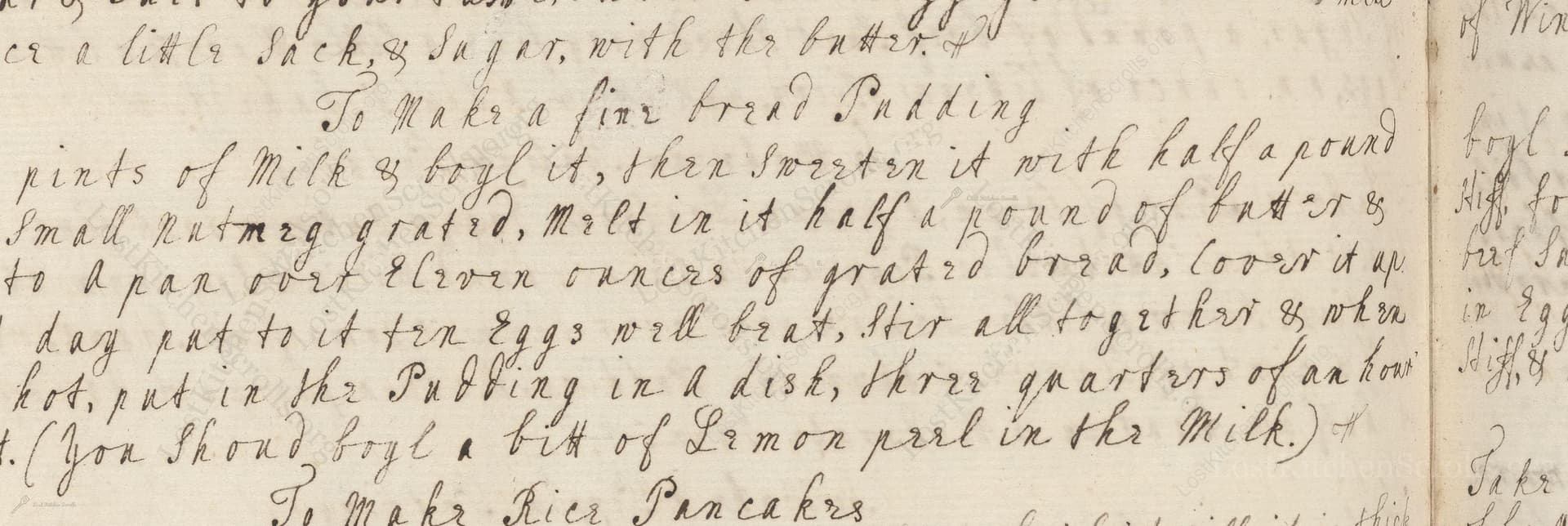To Make A Fine Bread Pudding
From the treasured pages of Cookbook of 1720 approximately
Unknown Author

To Make A Fine Bread Pudding
"Take three pints of Milk & boyl it, then sweeten it with half a pound of Sugar, a Small nut meg grated, Melt in it half a pound of butterr & a small peice of bread, cover it up till the Meat put to it ten Eggs well beaten, stir all together & when the oven is hot, put in the Pudding in a dish, three quarters of an hour will bake it. (You shoud boyl a bitt of Lemon peel in the Milk.)"
Note on the Original Text
This recipe is written in the narrative style characteristic of early 18th-century household manuscripts: brief, without precise measurements or detailed instructions, as it was assumed the cook had a working knowledge of kitchen techniques. Spelling and grammar are fluid, such as 'boyl' for 'boil' and 'Meat' likely meaning 'mixture,' or sometimes a scribal error. The text moves stepwise but expects familiarity with processes like tempering eggs and managing an oven's heat.

Title
Cookbook of 1720 approximately (1720)
You can also click the book image above to peruse the original tome
Writer
Unknown
Era
1720
Publisher
Unknown
Background
A delightful window into early 18th-century kitchens, this historical culinary tome brims with recipes, culinary wisdom, and the flavors of a bygone era—offering food enthusiasts a taste of both tradition and intrigue.
Kindly made available by
Folger Shakespeare Library
This recipe originates from early 18th-century England, around 1720, a period when bread puddings were a beloved staple for both economy and indulgence. Recipes like these were commonly found in handwritten household books among the British gentry and aspiring middle class. Such dishes made clever use of leftover bread, transforming humble ingredients with luxurious additions like butter, sugar, and eggs. The inclusion of spices and citrus peel reflected the expanding global trade and the availability of imported goods on English tables.

In its day, the milk would have been boiled over an open hearth in a heavy-bottomed pot, perhaps a cast iron cauldron or copper pan. The bread would be torn by hand. Lemons and nutmeg would be grated fresh with a small hand grater. Once mixed, the pudding would be baked in a deep earthenware or metal dish set into a wood-fired oven or hearth oven, watched closely for even baking. Wide wooden spoons, bowls, and perhaps a linen cloth for straining made the work easier.
Prep Time
20 mins
Cook Time
45 mins
Servings
10
We've done our best to adapt this historical recipe for modern kitchens, but some details may still need refinement. We warmly welcome feedback from fellow cooks and culinary historians — your insights support the entire community!
Ingredients
- 3 pints (6 cups) whole milk
- 8 ounces (1 cup) caster sugar
- half a whole nutmeg, grated (or 1–2 teaspoons ground nutmeg)
- 8 ounces (2 sticks) unsalted butter
- 1.5 ounces white bread (preferably slightly stale, crusts removed if desired)
- peel from 1 lemon (a strip, no pith)
- 10 large eggs
Instructions
- Begin by bringing 3 pints (6 cups) of whole milk to a gentle boil in a large saucepan.
- Add 8 ounces (1 cup) of caster sugar to sweeten, along with freshly grated nutmeg from about half a whole nutmeg.
- Drop in 8 ounces (2 sticks) of unsalted butter and stir until melted.
- Add a small piece (about 1.5 ounces) of white bread, torn into pieces, preferably with the crusts removed.
- Infuse the milk further by simmering it with a strip of lemon peel for a few minutes, then remove the peel.
- Let the mixture cool slightly, then whisk together 10 large eggs in a separate bowl.
- Gradually stir the eggs into the milk mixture.
- Pour everything into a buttered baking dish.
- Bake in a preheated oven at 350°F for about 45 minutes, or until the pudding is golden and set.
Estimated Calories
430 per serving
Cooking Estimates
You will need about 20 minutes to prepare the ingredients, then about 45 minutes to bake the pudding in the oven. Each serving has about 430 calories, and this recipe serves 10 people.
As noted above, we have made our best effort to translate and adapt this historical recipe for modern kitchens, taking into account ingredients nowadays, cooking techniques, measurements, and so on. However, historical recipes often contain assumptions that require interpretation.
We'd love for anyone to help improve these adaptations. Community contributions are highly welcome. If you have suggestions, corrections, or cooking tips based on your experience with this recipe, please share them below.
Join the Discussion
Rate This Recipe

Den Bockfisch In Einer Fleisch Suppen Zu Kochen
This recipe hails from a German manuscript cookbook compiled in 1696, a time whe...

Die Grieß Nudlen Zumachen
This recipe comes from a rather mysterious manuscript cookbook, penned anonymous...

Ein Boudain
This recipe comes from an anonymous German-language manuscript cookbook from 169...

Ein Gesaltzen Citroni
This recipe, dating from 1696, comes from an extensive anonymous German cookbook...
Browse our complete collection of time-honored recipes



